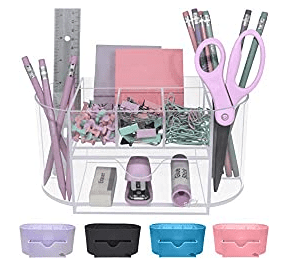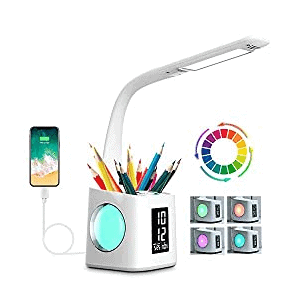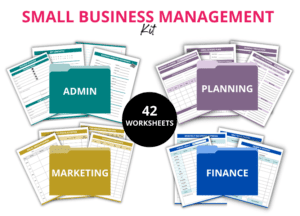Are you working from home or want to? If so, it can be a bit of an adjustment.
You may find that your productivity suffers without the right environment and tools to help you stay organized – I know this from experience!
That’s why having a Home Office Checklist is essential.
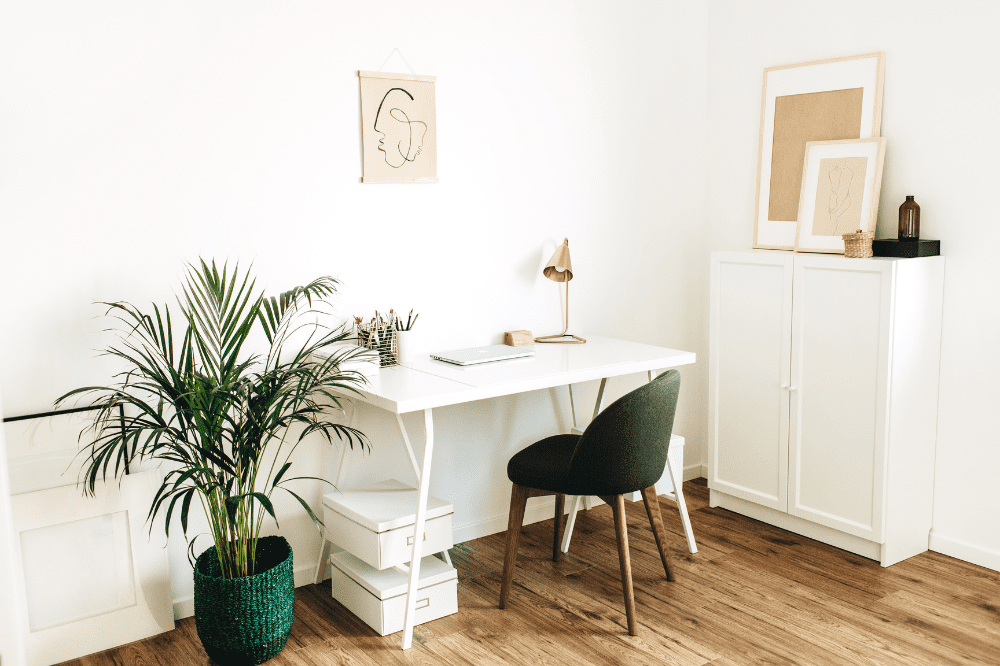 This post may contain affiliate links. Please see our disclosure policy for more information.
This post may contain affiliate links. Please see our disclosure policy for more information.
So in this article, as someone who as worked from home over the past 25+ years, I’m going to share my thoughts, ideas and tips on how to setup your home office so you can carry out your work effectively, efficiently and be super productive!
From ergonomic chairs to noise-cancelling headphones, this list details all the must-haves when setting up your workspace.
Topics which I’m covering are:
- Your Home Office Area Space
- Lighting, Color & Decor
- Ergonomics & Comfort
- Essentials & Supplies
- File Storage Solutions
- Computer Set-Up & Security
- Internet Connection & Network
- Productivity Tips
- Digital De-cluttering Tips
- Work/Life Balance
- Conclusion
So let’s get started…
Setting Up Your Home Office Space
Creating a home office is like building your own castle – you can design it to reflect your individual needs, allowing you to be the most productive and fulfilled version of yourself.
Start by deciding on an area where you will work.
You may use a corner in the living room, use the dining room or use a spare bedroom.
Small Spaces
Even if you use a corner of a room, there are plenty of options for furniture that fits into tight spots or folds away when not needed.
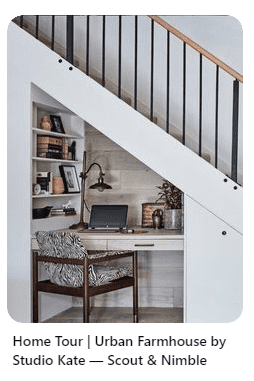 Take a look on Pinterest for ideas. I’ve just done a quick search on Pinterest for ‘small office ideas’ and I found a tiny office under the stairs!
Take a look on Pinterest for ideas. I’ve just done a quick search on Pinterest for ‘small office ideas’ and I found a tiny office under the stairs!
How cute and brilliant is that!
So definitely go to Pinterest for ideas and then shop online to find items you want. Amazon is a good place to start and you can also shop at places like Ikea.
Lighting, Color, And Decor Choices
As the old saying goes, “the devil is in the detail” as when it comes to furnishing your home office, there are many options available.
The following table provides a guide for selecting lighting, color, and decor choices that will best suit your needs as you work from your home office:
| Lighting | Color | Decor |
|---|---|---|
| Natural Light | Neutral Colors | Minimalistic Furniture Pieces |
| Task Lights (for focused tasks) | Accent Colors (to add character) | Ergonomic Office Chairs & Desks |
| Soft Mood Lighting (for relaxation) | Wall Art & Paintings For Inspiration | Organization Solutions To Keep Things Neat and Tidy |
If you’re looking for a relaxed and calm office environment, then think about light shades of blue. Blue is often used in interior design and decor to create a calming and soothing atmosphere.
Shades of green, gray, and lavender can also be associated with calmness and relaxation.
HOME OFFICE STARTUP CHECKLIST
Ergonomics And Comfort Considerations
Creating a comfortable and ergonomically sound workspace is crucial for any successful home office. An uncomfortable, cramped working environment can lead to poor posture, fatigue and possible injuries over time.
Here’s a checklist of items to consider when setting up the main items of your home office:
| Item | Considerations | Resources |
|---|---|---|
| Chair | Adjustable height and back support, lumbar support cushion if needed | Ergonomic Office Chairs |
| Desk surface | Roomy enough for computer, phone, documents, and supplies; anti-glare surface or mat as desired | Standing Desks |
| Keyboard & mouse | Arm rest(s), wrist supports if needed | Ergonomic Keyboards & Mice |
It’s also important to ensure that your monitor is at the right distance and angle – usually just below eye level – so you don’t have to bend your neck forward while looking at it.
If you need extra help seeing the screen clearly, invest in an anti-glare filter or try changing the lighting around your workspace area.
To take frequent breaks from sitting or standing in one place, use a timer on your desk or smartphone reminder so that you can stretch and move around every 30 minutes or so throughout the day!
With all these decisions made, now it’s time to move onto finding essential equipment and supplies…
Home Office Essentials & Supplies
Once you have your space, desk and chair sorted, you’ll need some of the basic essentials, such as:
- Computer with an internet connection
- Whatever software programs are necessary for the job.
- Printer/scanner
- Telephone line or VoIP service
You’ll also want to stock your desk with basic office supplies like pens and paper, notepads and folders.
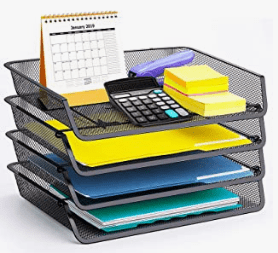 A good filing cabinet is also essential for keeping documents organized; plus consider getting some organizational tools such as stackable trays, binders, labels, etc.
A good filing cabinet is also essential for keeping documents organized; plus consider getting some organizational tools such as stackable trays, binders, labels, etc.
Finally, don’t forget about adding personal touches to your workspace: photos of family members or artwork can help liven up the atmosphere and make your office feel more inviting.
Office Organizational Tools
Here are some must-have items for organizing your workspace:
Desk organizers: These handy containers can keep all your pens, paperclips, and other small supplies sorted and within easy reach.
Desk Lamp: This a fantastic find. This is a desk lamp with a built-in phone charger – and it also has space for pens.
Printer cart or stand: This keeps your printer off the floor while providing extra storage space for ink cartridges, paper rolls, etc.
Wall shelves: Installing wall shelves provides additional storage space as well as an organized display spot for important documents or awards.
Having these essential organizational tools will create an orderly system that allows you to focus on tasks at hand rather than searching endlessly for missing items. Plus, when everything is in its rightful place – no matter how chaotic things might get – it’s much easier to find what you need quickly!
HOME OFFICE STARTUP CHECKLIST
File Storage Solutions
No matter how organized and tidy our office space is, we still need effective file storage solutions to keep track of our documents. Many people assume that the only way to store files is in bulky filing cabinets or on shelves but there are other options available as well.
Here are some great file storage solutions to consider:
Paperless Solutions: Using cloud-based services like Google Drive, Dropbox, and OneDrive can help us store large amounts of data securely without having to physically store paper copies.
You can easily access important documents from any device and even share it with others if needed.
Advantages: Cost savings (no physical storage costs) & No clutter
Disadvantages: Security concerns & Limited customization options
Traditional Filing Cabinets: While traditional filing cabinets may not be the most glamorous option around, they do offer an efficient way of organizing hard copy documents for easy retrieval.
The best part about this type of system is that it’s highly customizable depending on your needs.
Advantages: Ease of use & High level of organization
Disadvantages: Can take up a lot of space & Initial cost
For those looking for something more creative, repurposed furniture such as old dressers or bookcases can also provide stylish yet functional storage solutions for their home office.
Whether you go with a digital solution or decide to stick with a more traditional approach, make sure that whatever file storage solution you choose fits both your budget and lifestyle!
With the right kind of setup in place, you will be able to increase your productivity tenfold.
Computer Set-Up And Security
Now that we’ve got the organizational tools in place, it’s time to move on to setting up your computer for both security and efficiency.
Having a secure machine is paramount – no one wants to be vulnerable to malware or identity theft.
Fortunately, there are simple steps you can take to ensure maximum protection from digital threats.
| Task | Benefits |
|---|---|
| Install antivirus software | Detects viruses and blocks malicious links and files |
| Set strong passwords | Prevents unauthorized access to accounts and devices |
| Backup important files regularly | Protects data if device is lost or stolen |
| Use two-factor authentication (2FA) | Adds an extra layer of security when logging into websites |
Taking these precautions will help protect your personal information and keep cyber criminals away from accessing crucial files stored on your computer.
In addition, making sure that you have all the necessary hardware components installed correctly can make working from home much more convenient.
Make sure everything is connected properly and double check any network settings before getting started with work.
Next up, let’s talk about how having a reliable internet connection and networking set-up can maximize productivity while at home.
HOME OFFICE STARTUP CHECKLIST
Internet Connection And Networking
Creating a reliable and secure internet connection is essential for any home office.
Networking your devices can help you stay organized and efficient while completing tasks.
Here are three steps to get started:
- Check the speed of your current internet connection to ensure it meets the requirements of your work activities.
- Create a networked environment for all of your devices by connecting them with an ethernet cable or setting up a wireless router.
- Ensure that all necessary security measures, such as firewalls and antivirus software, have been implemented in order to protect your data from malicious intruders.
If you get stuck with this, as it is quite technical, ask someone to help you out, look at YoutTube videos or get an Internet Networking Company to advise you.
Productivity Tips
I’m sure we all want to be more productive in our home offices, so here are some simple tips that can help you maximize your productivity and get the most out of your workday:
Set-Up Systems
Set up systems for most of your daily and weekly tasks.
For example, you can set up systems for:
- Email Management
- Income & Expenses
- Social Media Posting
- Networking
- Client Work
Once you have systems set up, you will know exactly what to do and in what sequence of order.
You can even type your systems up in a Word or Google document, just in case you forget the sequence of steps or you want to hand over that particular task to an employee or virtual assistant.
Set a Realistic Daily Goal
for each day that is achievable within the allotted time frame. Break this down into smaller tasks; this will make it easier to stay on track and reach your goals quickly.
I have created this Small Business Management Kit which consists of 42 worksheets separated into the four main areas of a business: Admin, Planning, Marketing and Finance.
You can learn more about his toolkit here: >> Small Business Management Kit
I have also created an Income & Expenses spreadsheet to help you keep on top of your business finances.
Office Environment
Make sure that you create an environment where you feel comfortable working. Make sure everything you need is easily accessible so there isn’t any wasted time searching around for materials or tools.
It’s also important to take regular breaks throughout the day as well as give yourself enough time to rest and recuperate during evenings and weekends. This will help reduce stress levels which can lead to increased efficiency.
The Right Technology
Use technology wisely. Utilizing the right applications and tools can save you time while still allowing you to complete tasks accurately and efficiently.
Investing in quality equipment such as monitors, keyboards, mice, etc., will ensure that you have what you need at hand when needed without having to waste precious minutes looking for them online or offline.
Project Management Software
If you run a team or hire virtual assistants, then consider investing in some project management software.
Project management software is a useful tool for businesses of all sizes, even the smallest of businesses.
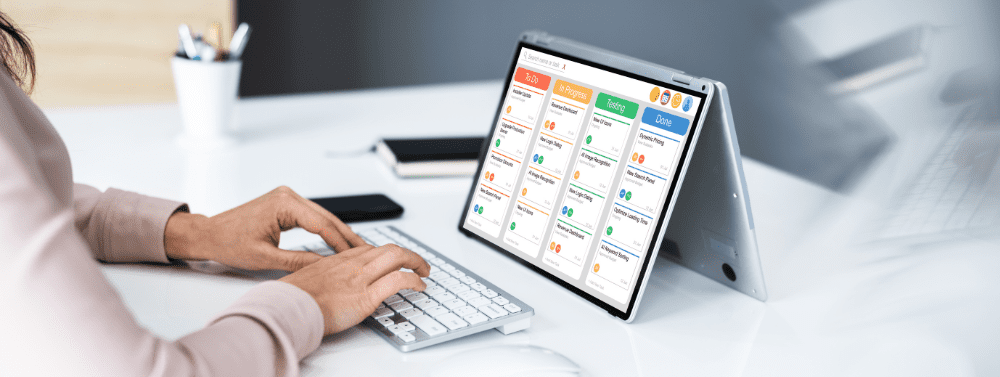
It allows teams to collaborate and stay organized while managing projects efficiently. It’s a great way to keep track of tasks, set deadlines, and monitor progress.
With project management software, teams can easily assign tasks, prioritize them, and ensure that everyone is on the same page.
There used to be only two major project management software applications which were Asana and Trello, but there are dozens of them today. I seem to see a company called Monday popping up all over the place.
So you’ll have to take some time and find a one which is best for you.
Keeping Your Office Clean & Tidy
And lastly, it’s important to keep your office space clean and tidy.
A clean space prevents distractions and allows you to properly concentrate on our tasks at hand. Plus, having an ordered area makes us feel calmer and relaxed while doing work at home – as the saying goes: “tidy desk, tidy mind!”
Having a good routine is key when it comes to maintaining a sparkling home office.
Related Reading: Follow this Home Office Cleaning Checklist
HOME OFFICE STARTUP CHECKLIST
Digital Decluttering Tips
Another task which you might want to get into the habit of is digital decluttering.
It can help reduce stress, minimize distractions, and even save time in the long run!
Here are some tips for getting started:
Start by assessing what digital clutter you have and where it’s coming from. What apps do you use? Are there any programs or services that could be streamlined or eliminated altogether?
Once you know what needs to be done, create a plan. Decide which items need to stay and which should go. This will also help with organizing any data into folders or categories so that everything has its own place.
Finally, take action!
- Uninstall unnecessary programs
- Delete unused files
- Tidy up your desk top screen
- Unsubscribe from unwanted emails, and
- Clear out any other digital clutter taking up space on your computer or phone.
Setting aside a few minutes each day to tackle this task will make all the difference when it comes to creating an organized workspace.
Work/Life Balance Strategies
Taking the time to create an effective work/life balance system can help you stay focused on your goals while maintaining your physical, mental, and emotional well-being.

If you run your own home-based business, then it’s hard to get the balance right as you’ll likely feel under pressure to put in more hours so you can see quicker success.
But this isn’t the right balance.
Here are some strategies that I have found helpful in achieving this important goal:
First, set boundaries between your home life and professional life.
Make sure you designate specific hours each day or week when you will focus exclusively on work tasks, such as answering emails or attending meetings.
Additionally, make sure you carve out enough time for yourself away from work responsibilities to relax and recharge.
This could include:
- Taking regular breaks throughout the day to stretch.
- Take a walk outside.
- Scheduling leisure activities like reading books or playing sports.
- Setting aside quality time with family and friends.
Second, prioritize self-care by taking care of your body’s needs through proper nutrition and exercise.
Eating balanced meals helps ensure that your energy levels remain steady throughout the day so that you have sufficient fuel for both work commitments and personal time.
Exercise also boosts endorphins which can naturally improve overall mood and reduce stress levels – two essential ingredients in any successful work/life balance strategy.
Lastly, it’s important to invest in digital decluttering tips to help keep distractions at bay while working from home.
This might involve:
- Turning off notifications on all devices during designated ‘work’ times.
- Creating folders on your computer desktop specifically for documents related to current projects.
- Using online tools like calendar reminders to avoid forgetting important deadlines.
- Establishing clear guidelines regarding social media use during office hours.
Making these small but significant changes can give us much needed control over our schedules – and ultimately lead us closer towards achieving long-term success amidst our busy lives!
HOME OFFICE STARTUP CHECKLIST
Conclusion
Working from home, whether full-time or part-time, can be a great way to stay productive and achieve success. But it’s also important to make sure you have a comfortable office space that allows you to work efficiently.
By following this home office checklist, I’ve hopefully given you the tools to get set up for success.
Now that your workspace is ready, take some time to focus on yourself too!
It’s easy to get bogged down in the minutiae of day-to-day tasks and lose sight of what really matters: mental health and well-being.
Take regular breaks during the day, even if it’s just for five minutes, and don’t forget about exercising regularly.
In other words, don’t let working from home become an all-consuming task; instead, use this newfound freedom wisely!
Hi, I’m Claire Bullerwell
I’ve ran dozens of home-based businesses, both offline and online, since my early twenties. I started this blog to share all my wealth of knowledge and experience to help women just like you; to find your dream home business and to live your best life.
Follow me and let’s get acquainted…


